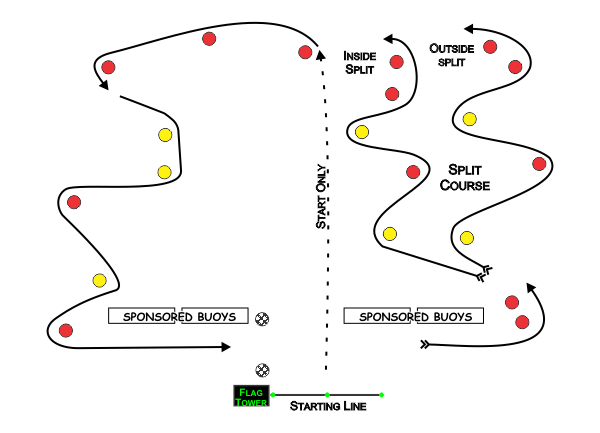STAND-UP PADDLEBOARDING WITH SOME TWIST & TURNS...

WHAT IS SUPXROSS?
Simply put, it is Stand Up Paddleboard racing on a closed course... Stand-up Paddleboard (SUP) racing is typically done on a long course, most commonly occurring on rivers or along the shoreline of lakes and ocean waters. SUPcross uses the same closed course race track that is use in watercross (aka jet ski racing).
SupXross offers the most dynamic setting found on flat water…period! It bridges the extensive gap between standard “straight-line” SUP races, and the more extreme elements of whitewater SUP racing; by eliminating any unforeseen hazards, and establishing a safe, contained environment within a closed course race track, this allows paddlers (of all abilities) the “SUP-racing ride of their life”!
SupXross will push these athletes to their limits as they take sharp left and right turns, testing their agility and stamina. The closed course features a buoy-marked track that is designed to keep the competition tight and fans close to the action. Speed, technique and determination will all come into play throughout each race, with as many as 20 paddlers negotiating a series of pivot turns and straightaways in this qualifying style of racing that include heats, semi-finals and finals. The vision for having single-lap heats, is to keep the pace as high as it could get in any sports arena. With a short-enough distance to keep the pace at peak level, yet just long enough to allow for contested lead-changes and sudden shifts in momentum, “SupXross” possesses those pivotal moments that will live on in the history of sports forever!

BOARD SIZES & CLASSES
BOARD SIZE
Up to 14'
Up to 14'
Under 12'6"
Up to 14'
Up to 14'
Under 12'6"
Up to 14'
Under 12'6"
CLOSED COURSE PADDLING
Pro-Am (16 yrs +)
Amateur (16 yrs +)
Open (16 yrs +)
Legends - Co-Ed (50 yrs +)
Pro Juniors (12-15 yrs)
Juniors Open (15 yrs & under)
Pro-Am Women's (16 yrs +)
Women's Open (16 yrs +)
During “SupXross” competitions, racers are assembled into heats of up to 20 competitors at once. They begin the race in an even line, typically starting on the water, yet at some venues there can be a “beach start” where racers charge the water with their board in hand before jumping on it.
There will always be a thrilling sprint to the first buoy turn, in hopes of having a clear path to the rest of the buoys throughout the closed-course! Positioning will be highly contested on straightaways and as racers jockey for position going in to tight pivot turns. Some contact may occur between boards and paddles, however never between the paddlers themselves. As the saying goes…” Rubbing is Racing”!
Paddlers will pursue the top places to auto-qualify for the finals, whereas other paddlers that finish in the top half of the pack, will get another opportunity to still qualify for the finals by racing additional heats. “SupXross” will ultimately demand athletes to possess a diverse array of aggressive board stances, technical paddle strokes, and fuse athleticism with a focused tenacity to achieve victory! It is…without a doubt, the future of flat-water SUP racing!
What are the different color buoys for?
Huge colorful buoys are used to indicate turns in the race course. The Pro Watercross Tour also uses long hot-dog inflatables to mark the merge lane from the split course.
THIS IS A SAMPLE COURSE - RACE DAY COURSE WILL BE DIFFERENT
Red Buoy:
A red buoy indicates a left turn. Two or more red buoys may be put in a line to form a large sweeping left-hand turn.
Yellow Buoy:
A yellow buoy indicates a right turn. Two or more yellow buoys may be put in a line to form a large sweeping right-hand turn.
Buoy colors direct the racer to turn. RRED signifies a left turnn,
Y YELLOW is for right t.
Checkered Buoys:
Checkered buoys indicate the Start/Finish line. A rider must pass through these buoys for a lap to be counted.
Penalty Buoy:
The penalty buoy is to be used in the case of a missed buoy. The penalty buoy may be any color buoy that is designated by the Race Director and stands out and away from all other buoys on the race course. If a rider fails to properly negotiate, or misses a buoy, that rider must properly negotiate the penalty buoy instead of reattempting the missed buoy.
White/Other Color Buoys:
White buoys or other colored course bouys are used to mark the outside lane of a racecourse utilizing a two-lane split start. White buoys are also used to mark turns on the Slalom event and to mark the merge lane in the case of a “split” type racecourse.
“Hot-dog” inflatables are typically sponsored buoys and can also be used to establish a merge lane on a split-type racecourse. Other Color buoys are often used on the outside of the race course to control boat traffic from entering the racecourse.
